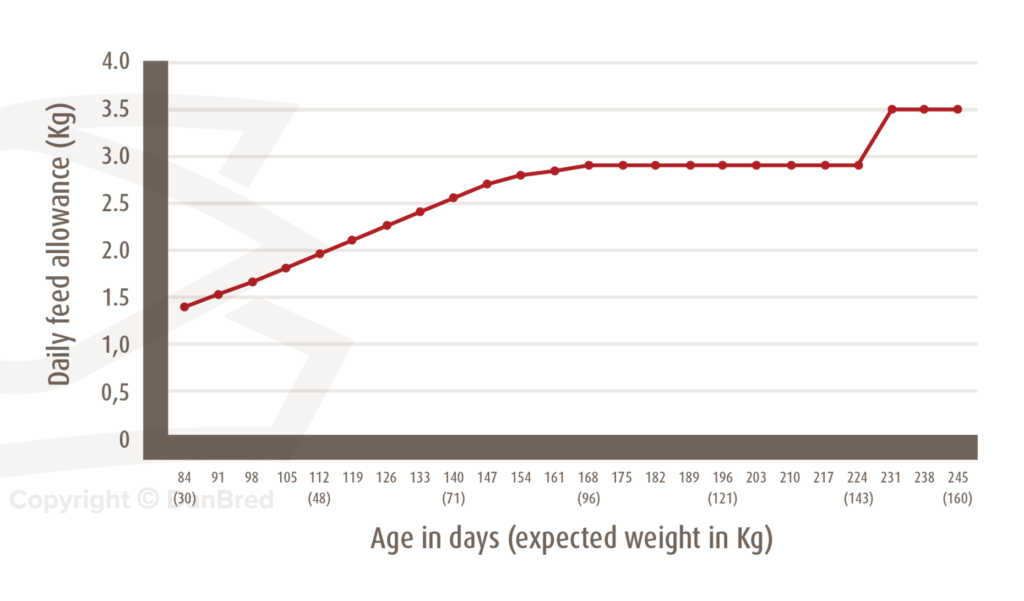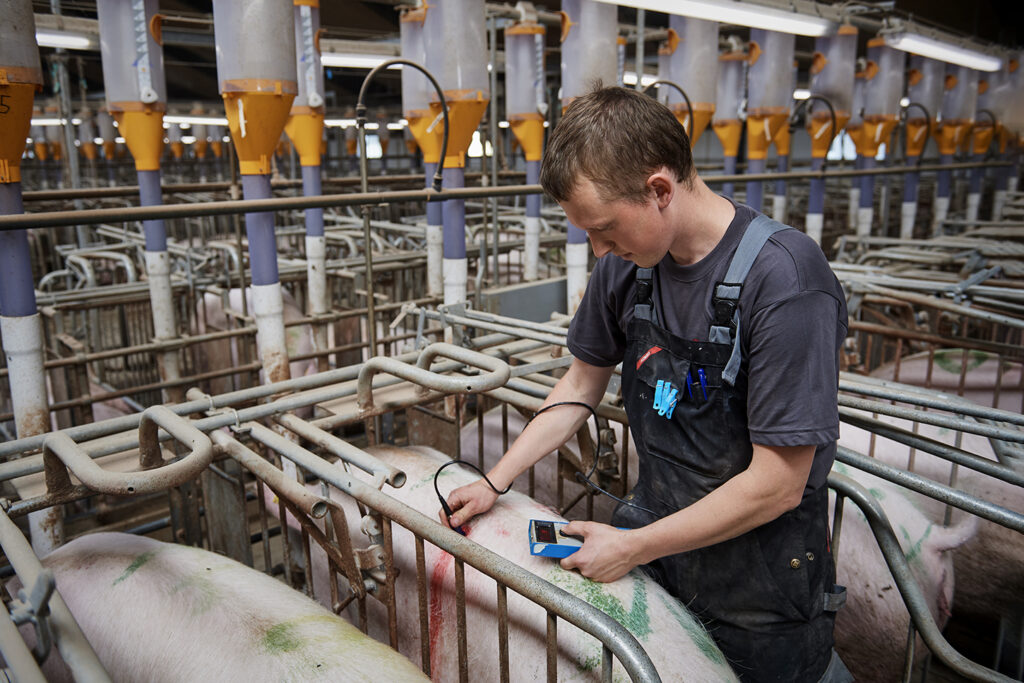Gilt feeding – Restricted phase feeding
Content
How to maximize lifetime productivity
Gilts represent the future production of sow herds and DanBred gilts come with an extraordinary genetic potential for reproductive performance.
Optimum feeding of gilts using restricted phase feeding


Gilts represent the future production of sow herds and DanBred gilts come with an extraordinary genetic potential for reproductive performance. Careful attention when feeding the DanBred gilt will be rewarded in the farrowing unit and set a prime starting point on the road to release the genetic potential for consistently high lifetime productivity.
The ideal feed curve for DanBred gilts will ensure a balance of the feed amount in relation to the age and weight of the gilts as shown in figure 1 (to the left).
The huge potential for growth in the DanBred animals means that there must be a focus to limit the growth rate in the DanBred gilts, which is why the feed energy level is a very important factor when working with DanBred gilts.
The optimum lifetime production for DanBred gilts is reached when the gilt is mated for the first time in the second heat, at the age of 230-250 days weighing between 140-160 kg with a back-fat thickness of 14-15mm at the P2 measuring point (2).
Moderation of gilt growth

| Age, Days (weeks) | Weight, Kg | ADG, (g/day) |
| 28 (4) | 7 | 250 |
| 56 (8) | 17 | 430 |
| 70 (10) | 25 | 430 |
| 84 (12) | 30 | 500 |
| 112 (16) | 48 | 500 |
| 140 (20) | 71 | 500 |
| 168 (24) | 96 | 570 |
| 196 (28) | 121 | 615 |
| 224 (32) | 143 | 640 |
| 245 (35) | 160 | 650 |
| From 56 to 135 days | 145 | 770 |

The feeding strategy for DanBred gilts is set to meet their nutrient requirements as well as maximise their long-term productivity.
A daily gain of 750-800 g/day from 30 kg to 140 kg will lead to the best possible basis for long-term reproduction productivity in DanBred gilts [2].
Feeding of DanBred gilts should ensure a steady, continuous but controlled weight gain throughout the period of growth. Expected weight development from following the DanBred recommendations is shown in figure 2.
The target is to initiate puberty and the onset of the oestrus cycle, support the pre-pubertal mammary development and maximise the productivity on litter size and longevity.
Studies indicate that the age of the gilt, as well as the correct introduction of boar contact, are the main factors when it comes to the onset of puberty [2][3].
The amount of body fat in the gilts might help the onset of puberty in gilts [1]. In a 2004 trial Vestergaard et. al. found that 50 to 60 % of sows were culled due to leg problems.
The moderated growth rate for replacement gilts has shown to positively correlate with sow longevity, as the managed growth rate has a positive effect on bone growth- giving the gilts stronger legs and thereby increasing longevity in breeding animals [5].
Moderating growth and increasing fat deposits through feeding will give lighter but slightly fatter gilts at the age of first mating. As the body fat content can play a role in the onset of puberty, it is important to ensure a back fat target of 15 mm (at least 14 mm) at the first mating.
Mammary development in the replacement gilts is not affected by the more linear growth curve, as the vast part of the udder, growth happens in the last third of gestation [2].
The size of the first litter might be marginally decreased with a steady growth rate, but flushing the gilts before mating has proven to be a very efficient way of increasing the ovulation rate at mating in the second oestrus and thereby enlarging the litter size [1].
Easy gilt feeding strategies to reach optimum DanBred reproductivity targets
To reach the full potential of DanBred gilts, the following targets should be met at first mating:
- Age: 230-250 days (32-35 weeks)
- Weight: 140-160 kg
- 14-15 mm back fat at the P2 measuring point.
- First mating on the 2nd heat
- Start boar exposure daily at the age of 200 days (28 weeks)
To efficiently control daily gain, the DanBred gilts must be fed diets containing less crude protein and lysine than finisher pigs. Restricted phase feeding with three different diets from 30 to 140 kg is recommended.
The feeding curve (figure 1) shows phase feeding based on feed with a content of 9.5 MJ NE/12.5 MJ ME/1.05 EW per kg of feed.
At a weight of 110 kg, the diet should be changed to promote the deposit of back fat. Energy density should be kept but Standardized Ileal Digestible (SID) lysine should be reduced, and the gilts should be fed based on body condition.
The table below shows the recommended content of selected nutrients per kg feed, when using restricted phase feeding or using a single diet from 30 to 110 kg followed by a diet formulated to weaned/dry sows.
| Restricted feeding | Diet phase 1 | Diet phase 2 | Diet phase 3 | Single diet |
| Weight | 30-65 kg | 65-110 kg | Gilts >110 kg1 | Gilts 30-110 kg |
| Energy density per kg feed
|
9.7 MJ NE/
12.6 MJ ME/ 1.06 EW |
9.5 MJ NE/
12.5 MJ ME/ 1.05 EW |
9.5 MJ NE/
12.5 MJ ME/ 1.05 EW |
9.5 MJ NE/
12.5 MJ ME/ 1.05 EW |
| SID Lysine per kg feed (g) | 8.2 | 5.3 | 4.2 | 6.3 |
| Total lysin per kg feed (g) | 9.4 | 6.5 | 5.2 | 7.4 |
| Minimum SID crude protein per kg (g) | 125 | 100 | 95 | 105 |
| Phosphorous per kg (g) | 5.8 | 4.6 | 4.2 | 4.9 |
| Digestible phosphorus per kg (g) | 3.2 | 2.4 | 2.1 | 2.6 |
| Calcium per kg (g) | 7.8 | 6.8 | 6.8 | 7.2 |
1This is also recommended for the mating unit.
*NE = Net energy,; ME = Metabolic Energy; EW= Net Energy in Dutch evaluation system
References
[1] Beltranena, E., Aherne, F. X., Foxcroft, G. R. og Kirkwood, R. N. (1991): Effects of pre- and postpubertal feeding on production traits at first and second estrus in gilts. Journal of Animal Science. 69: 886-893.
[2] Bruun, T.S., Sørensen, G.; Tybirk, P. (2014): Baggrund for næringsstofnormer til polte fra 30 til 140 kg. Notat nr. 1418, Videncenter for Svineproduktion
[3] Foxcroft, G., Beltranena, E., Patterson, J., Williams, N., 2005. The biological basis for implementing effective replacement gilt management. In: Proceedings of 2005 Allen D. Leman Pre-Conference Reproduction Workshop, Saint Paul, Minnesota, 17–20 September, pp. 5–25.
[4] Sørensen, G. (2006): Fodring af polte i opvækstperioden. Meddelelse nr. 741. Videncenter for Svineproduktion, Den rullende afprøvning.
[5 ]Sørensen, G. (2011): Betydning af poltes væksthastighed for livslængde og produktivitet. Meddelelse nr. 916, Videncenter for Svineproduktion.
[6] Vestergaard, K. (2004): Afgangsårsager hos søer – samt obduktionsfund hos aflivede og selvdøde søer. Meddelelse nr. 656, Landsudvalget for Svin.




